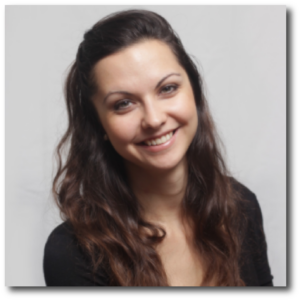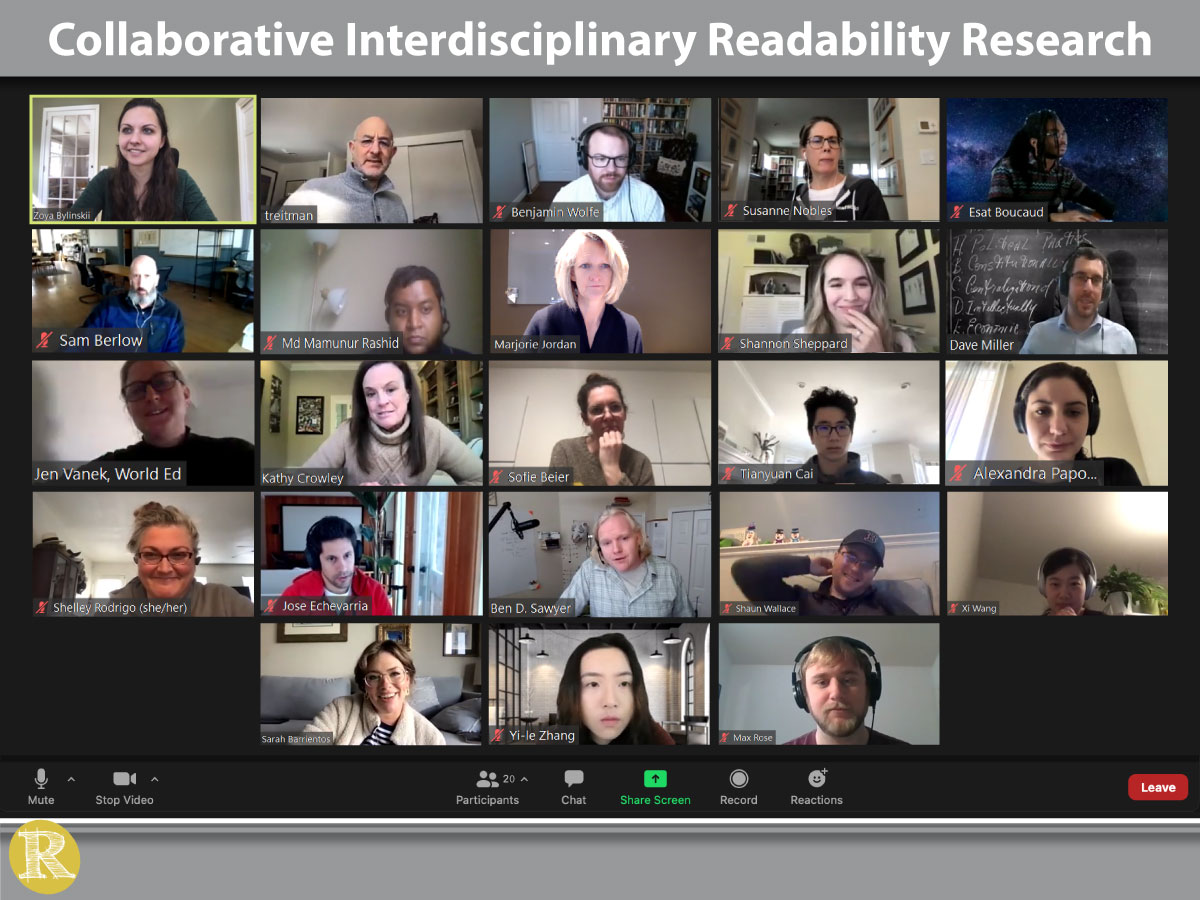The Launch of a Readability Research Community
Bringing Together Experts From Vision Science, Cognitive Science, Human Factors, Education, Typography, and more
 Dr. Zoya Bylinskii, Research Scientist at Adobe, began exploring readability in 2019 with her Adobe collaborator Rick Treitman, together with an intern – PhD candidate Shaun Wallace of Brown University. Coming to the project with a background in human vision and human computer interaction, Zoya sought specific expertise related to reading, and tapped into her vision science network to find it. Zoya, Rick, and Tong Sun, Director of the Document Intelligence Lab at Adobe, then sat down over the course of multiple brainstorming sessions with human vision experts Drs. Ben Sawyer, Ben Wolfe, and Jon Dobres, previous members of an MIT laboratory studying typographic legibility. The talented trio had investigated questions related to single-word reading at-a-glance with applications to smartwatches and vehicle dashboards, as well as the legibility of typography against complex backgrounds – with a nod to the increasing popularity of Augmented Reality interfaces.
Dr. Zoya Bylinskii, Research Scientist at Adobe, began exploring readability in 2019 with her Adobe collaborator Rick Treitman, together with an intern – PhD candidate Shaun Wallace of Brown University. Coming to the project with a background in human vision and human computer interaction, Zoya sought specific expertise related to reading, and tapped into her vision science network to find it. Zoya, Rick, and Tong Sun, Director of the Document Intelligence Lab at Adobe, then sat down over the course of multiple brainstorming sessions with human vision experts Drs. Ben Sawyer, Ben Wolfe, and Jon Dobres, previous members of an MIT laboratory studying typographic legibility. The talented trio had investigated questions related to single-word reading at-a-glance with applications to smartwatches and vehicle dashboards, as well as the legibility of typography against complex backgrounds – with a nod to the increasing popularity of Augmented Reality interfaces.
Motivated by Readability Matters’ initial findings of the dramatic effects of text format changes on the reading outcomes of children, Shaun Wallace’s Adobe internship project was centered around proving out similar gains for adult readers – something that had been previously observed (Boyarski et al., Bernard et al.), but not quantified at-scale. Leveraging Shaun’s expertise with running large-scale user studies and software engineering, the team went to work designing an experiment that was set to answer the question: considering adult readers,
“Are there 6 best reading formats or 600?”
The resulting effort collected the data of over 500 crowdsourced participants, to test 16 fonts for preference, reading speed, and comprehension. The key take-aways? (1) Fonts are highly personalized – different fonts work best for different people; (2) People’s preferences and familiarity for fonts don’t dictate which fonts are actually most effective; (3) The potential gains of customizing font to the individual increase reading speeds by 14% on average. (More details in a previous blog post.)
Fueled by the immense implications of these research findings to improving readability for all, Rick, Zoya, and Tong worked with Dr. Ben Sawyer to set up a Readability Lab at the University of Central Florida to continue to study readability questions with large adult populations, while leveraging eye tracking and brain imaging technologies. Hit with the onset of COVID-19, these efforts pivoted to a Virtual Readability Lab, since branded the VRL.
By the summer of 2020, the team of experts looking towards readability was rapidly expanding. Zoya and others were regularly tapping into their professional networks to bring in diverse expertise from academic fields focused on eye tracking and psycholinguistics, to design and typography, as well as education, and recently, audio processing. This cross-disciplinary group, 30+ members strong, has been meeting on a bi-weekly basis to plan, execute, and discuss readability studies from multiple angles – taking into account human factors, design, and educational considerations. The team that has thus come together is incredibly diverse – the observable characteristics being just the tip of the iceberg.
Cross-disciplinary participation is key to Zoya’s projects, who says “research is most exciting when it borrows from multiple fields, has broad appeal, and creates knowledge at new junctions”.
“What gets me up in the mornings (other than my toddlers) are the opportunities to engage, throughout the day, with collaborators all over the world, representing different perspectives that I can learn immense amounts from. Research projects motivated by real-world problems with societal implications are most exciting!”
Indeed, the team’s initial readability findings have been well received by multiple communities, being presented at two academic conferences in 2020 – the Vision Sciences Society (talk recording) – a premiere venue for disseminating human vision research, and CHI – a top international Human Computer Interaction conference (paper). Earlier in 2021, the team presented at SXSW EDU, axe-con, and COABE with more planned for this year.
Currently in the pipeline is an open-source toolkit that will be released to the research community to democratize the study of readability and offer reading passages, experiment code, and datasets, as well as a paper the team is planning to publish on “Interdisciplinary Readability Research Methods”. How does one orchestrate a 30+ author paper? Zoya has promised us a future blog post on this very topic.
This cross-disciplinary research effort is key to shifting the focus from what is best for the population to focusing on what is best for the individual. Findings from this research will be applicable to the design of better reading tools and most importantly, better reading experiences for the end consumer – you.
The Readability Research Community
Pictured (Left to right, top to bottom)
Dr. Zoya Bylinskii, Adobe
Rick Treitman, Adobe
Dr. Benjamin Wolfe, University of Toronto, Mississauga
Dr. Susanne Nobles, ReadWorks
Esat Boucaud, University of Central Florida
Sam Berlow, Typography for Good
Md Manumur Rashid, University of Central Florida
Marjorie Jordan, Readability Matters
Dr. Shannon Sheppard, Chapman University
Dr. David Miller, University of Central Florida
Dr. Jen Vanek, World Ed
Kathy Crowley, Readability Matters
Dr. Sofie Beier, The Royal Danish Academy of Fine Arts, School of Design
Tianyuan Cai, Adobe
Dr. Alexandra Papoutsaki, Pomona College
Dr. Rochelle (Shelley) Rodrigo, University of Arizona
Dr. Jose Echevarria, Adobe
Dr. Ben D. Sawyer, University of Central Florida
Shaun Wallace, Brown University
Dr. Xi Wang, ETH Zurich
Sarah Barrientos, University of Central Florida
Yi-Le Zhang, University of Washington
Maxwell Rose, Pomona College
Not Pictured
Dr. Jenae Cohn, California State – Sacramento
Dr. Tilman Dingler, University of Melbourne
Dr. Jonathan Dobres
Dr. Jennifer Healey, Adobe
Dr. Rajiv Jain, Adobe
Dr. Zeyu Jin, Adobe
Bernard Kerr, Adobe
Chanha Kim, Pomona College
Xander Koo, Pomona College
Qisheng Li, University of Washington
Dr. Tina Rezvanian, Adobe
Dr. Justin Salamon, Adobe




